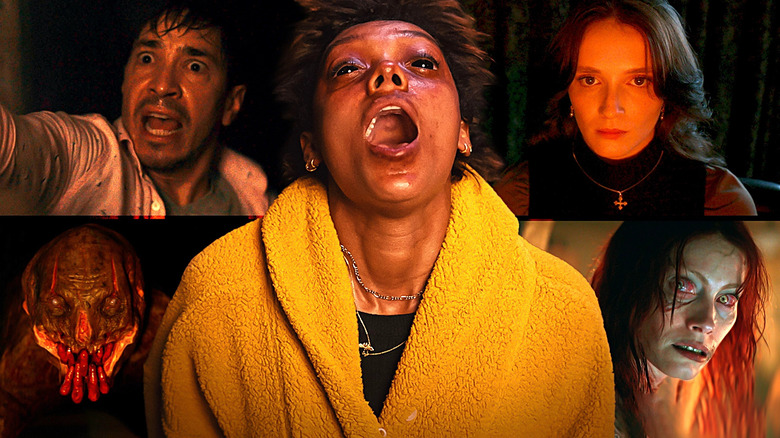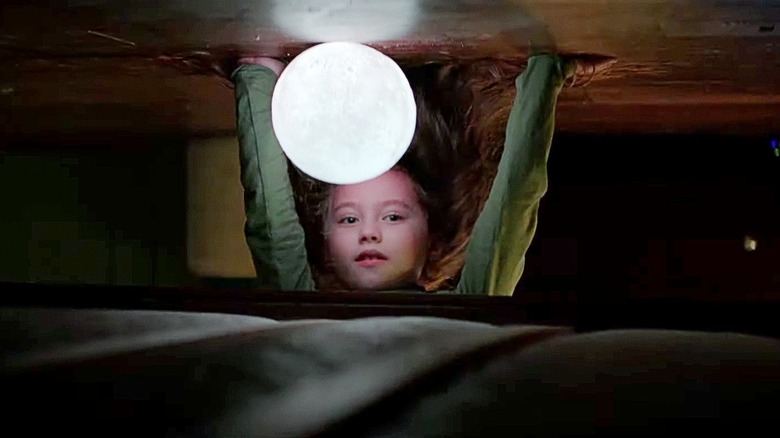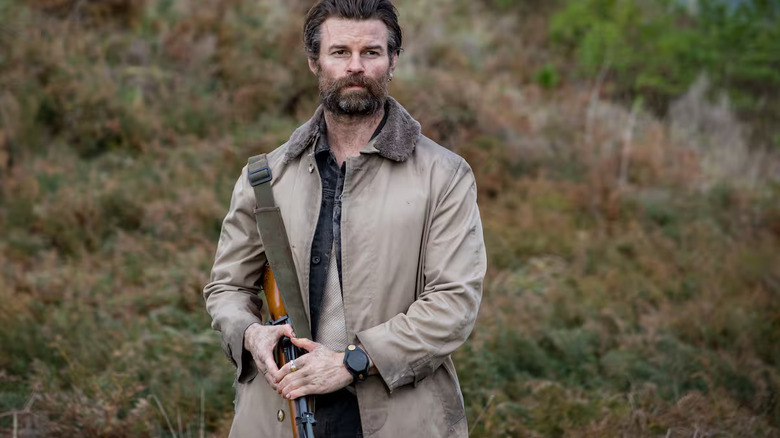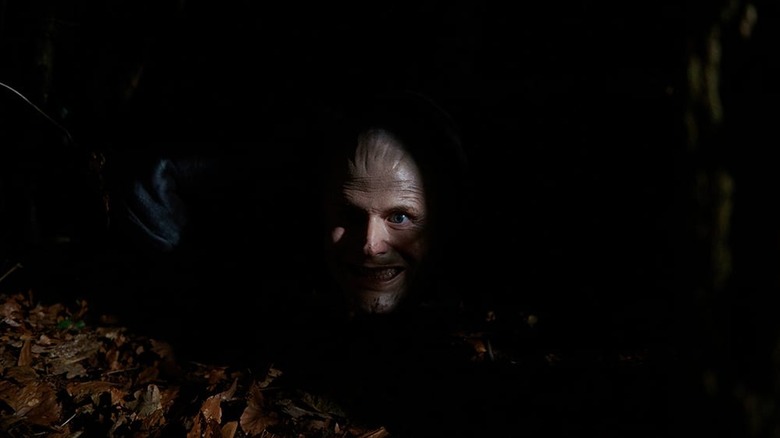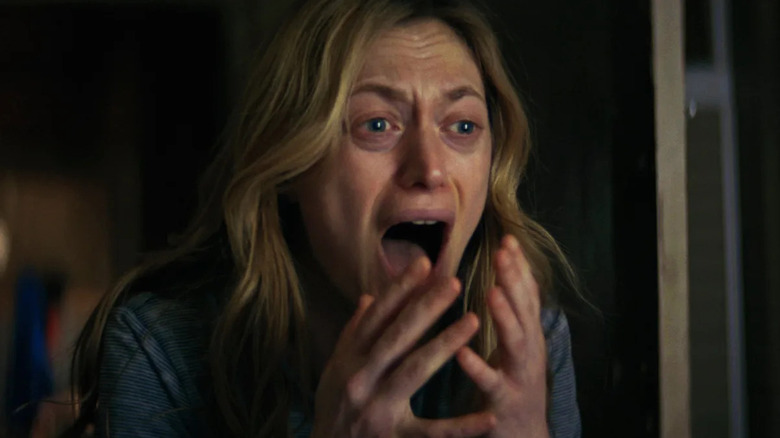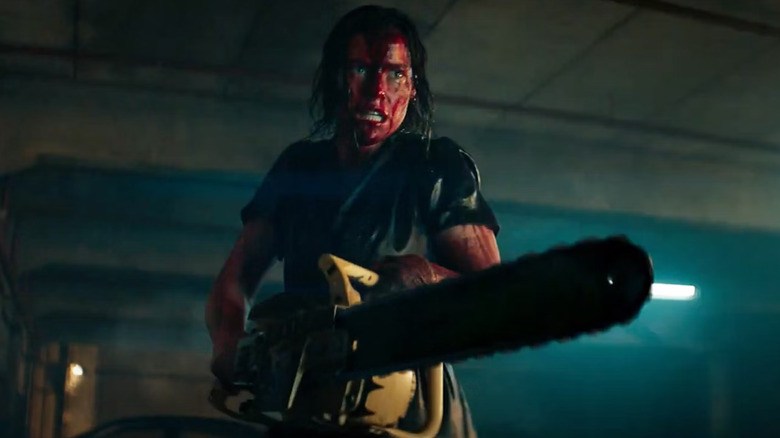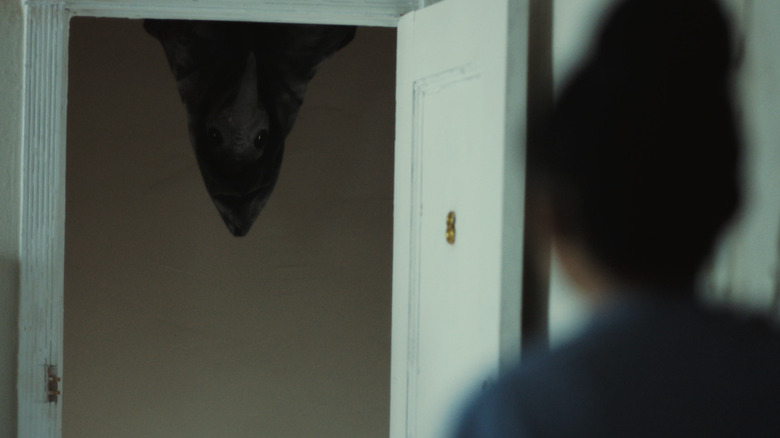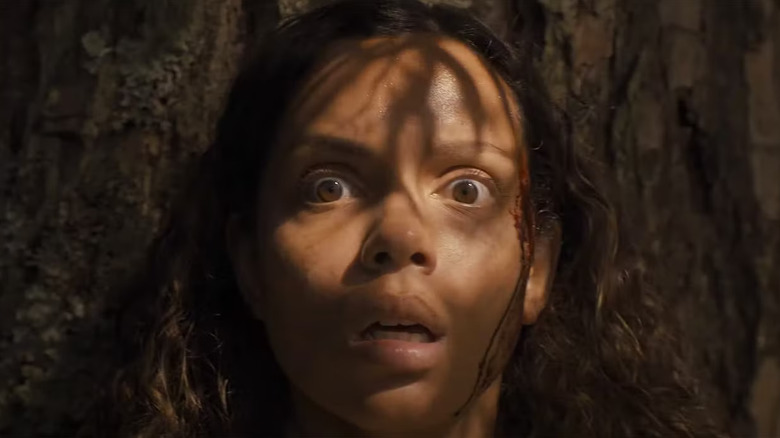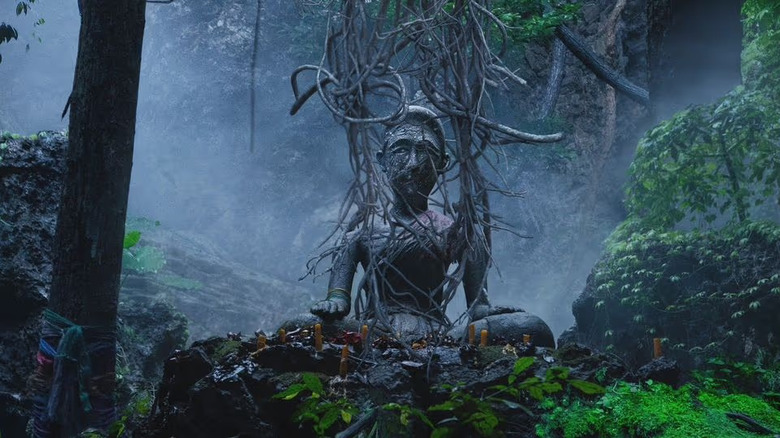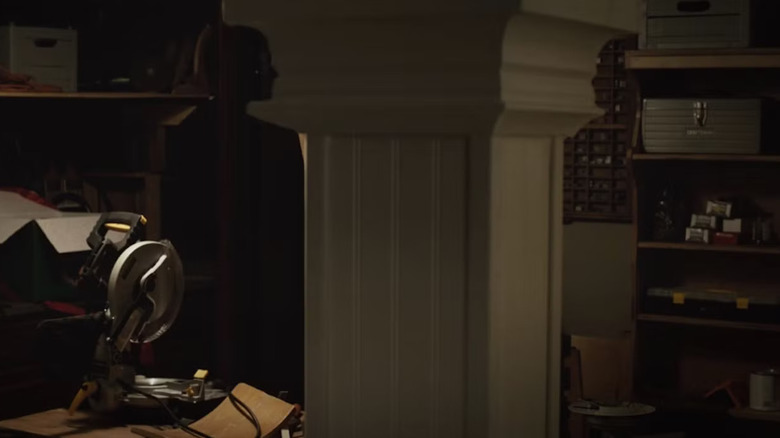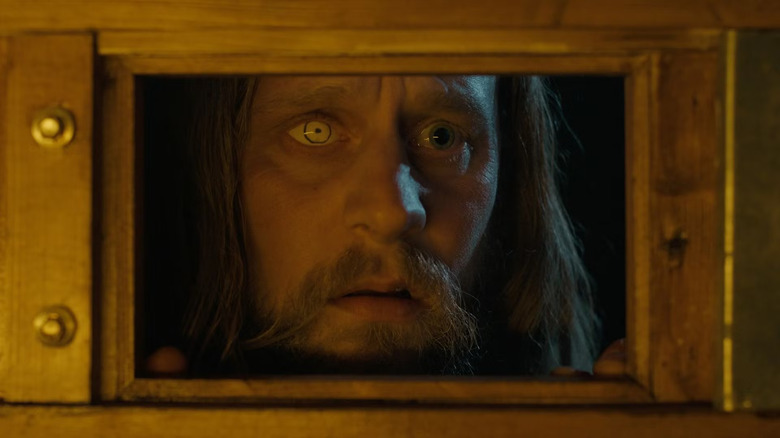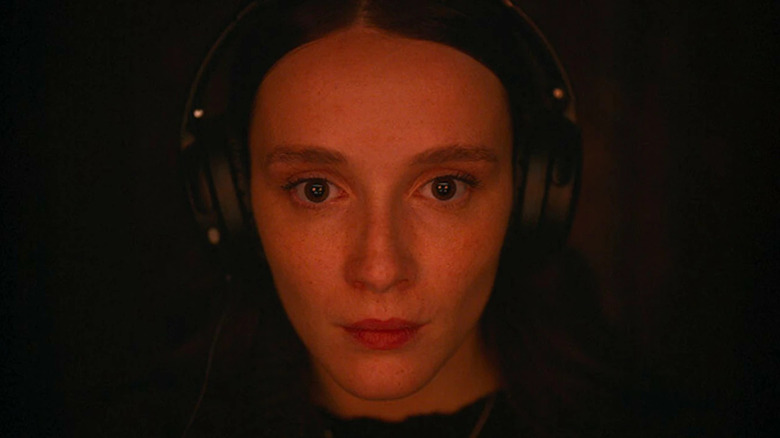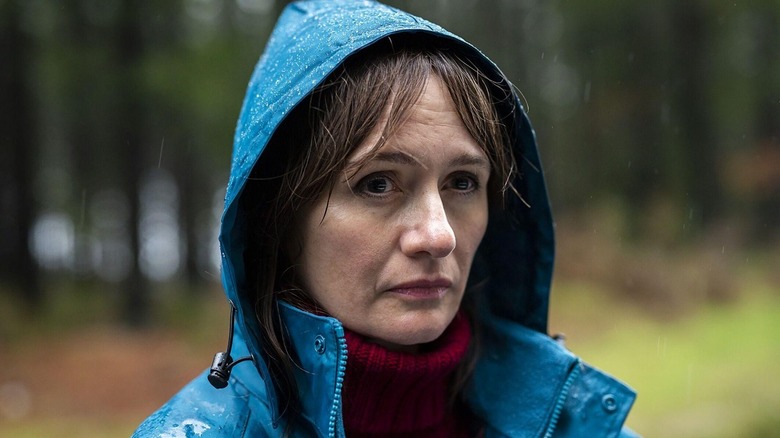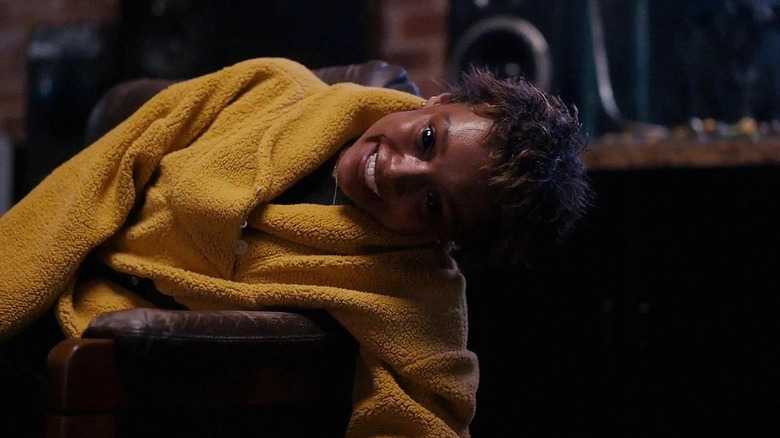The 15 Scariest Movies Of The 2020s (So Far)
Like the movies that make us laugh and the films that disturb us, fear is a subjective feeling. What scares one person might make the next one yawn because our fears are personal. Horror films complicate things further with the truth that they're not even always designed with scares in mind. Sometimes, they just want to deliver thrills, monster mayhem, and dark laughs instead.
The ones that do want to frighten viewers have a hefty toolbox at their disposal (one that includes jump scares, editing, atmosphere, and tone), and the 15 films below use all of them to leave audiences shaking, squirming, and squeezing their arm rests. We're not ranking them because, as mentioned, fear is personal, but it's also because every one of these movies delivers their own chills in their own ways. They're all worth seeking out, and with Halloween right around the corner, there's no better time to add them to your watchlist.
Now keep reading for a look at the 15 scariest movies of the 2020s so far.
Barbarian
We're loath to spoil the fantastically fun surprises in Zach Cregger's "Barbarian," but there's no real way to talk about the film's various scares without hinting too much. So, consider this your warning — if you haven't seen the film yet but plan on watching it, skip to the next title right now. We'll wait. Okay, still here? Good, let's talk about the many layers of creepy brilliance in "Barbarian."
The film kicks off with a man (Bill Skarsgard) who may or may not be a threat to a woman (Georgina Campbell), and Cregger milks the situation for all the suspense and tension possible. There's a twist, though, when she heads into the basement of her Airbnb only to discover a hidden doorway, a deep stairwell, and something even more terrifying. Cregger and friends are constantly a step or three ahead of viewers, and while he serves up some strong jump scares, the atmosphere of uncertainty is every bit as unsettling as we move from suspense thriller to creature feature. Terror is ramped up only for a welcome tone change and big laughs to calm you back down — before dialing up the horror again. Rinse, repeat, right on through to a pitch-perfect ending.
The Boogeyman
Stephen King may be the king of horror, but very few of the films adapted from his work are actually scary. Of the handful that are genuinely creepy, most of them were released in the early days of King's filmography, and that alone makes Rob Savage's 2023 movie "The Boogeyman" a rarity. The film focuses on two sisters dealing with the death of their mother and the slow submission from life exhibited by their father. That's already tough enough, but a dark presence soon makes itself known, leaving them terrified and desperate for help.
Horror movies exploring grief through monstrous metaphors have been fairly ubiquitous over the past decade, but far too many of them focus on the metaphor at the expense of the horror. "The Boogeyman" succeeds where others fail as Savage crafts some truly memorable and chilling set pieces to subject his characters to, and they make for a frightening and unsettling suburban nightmare. The creature design, another area where too many films falter, is also terrifically creepy and a being capable of scaring adults and children alike.
Coming Home in the Dark
James Ashcroft's "Coming Home in the Dark" is the first of only two films on this list that don't trade in supernatural or unnatural happenings. That real world setting makes the horror of what's unfolding all the more terrifying because it could happen to you. Ghosts, monsters, demons — they're spooky fun compared to someone intent on causing you and your loved ones unspeakable harm.
Two men approach a family of four at a rural rest area, but what starts as a robbery grows to include abduction, murder, and mind games revolving around past sins and present culpabilities. Ashcroft delivers a gorgeous film, a real accomplishment given the ugliness unfolding before our eyes, and scenes of suspense often end with unexpected violence. That terror, the possibility that something, anything horrible is likely to happen, makes for a terrifying watch that will haunt your memories the next time you're driving down remote roads with your partner or children. Uncertainty is scarier than just about anything when the lives and well-being of those you love hangs in the balance.
Daddy's Head
While "Daddy's Head" might sound like a title belonging to a sill romp or a gory good time, it's instead the name of another terrifically crafted horror movie giving a face to grief. Isaac (Rupert Turnbull) is mourning the death of his father, and the boy seems to be going a different route. He starts seeing his dad in his room, in the air vents, in the shadows — but what he's seeing isn't his father. And it certainly isn't human.
Picture a twisted, legitimately frightening take on John Carpenter's "Starman," and you'll be in the right mindset for what writer/director Benjamin Barfoot is serving up here. He makes tremendously effective use of shadows and delivers some genuine scares as the boy sees and hears his dad's face whispering to him from the darkness. That titular entity comes to vividly frightening life via a sharp combination of prosthetics and visual effects, and sealing the deal is Turnbull's performance as a young boy dealing with sadness, anger, and some understandable confusion as to what exactly is happening.
The Dark and the Wicked
While several horror films give life to its deadly threats as a metaphor for grief, "The Dark and the Wicked" instead uses that grief as a way to pry its way inside of its characters. Louise and Michael are adult siblings who return to their parents' rural farm as their father counts down his final days on his death bed. They're grieving the imminent, and it leaves them unprepared to deal with the utter evil that's hanging in the air all around them.
Writer/director Bryan Bertino made his name with 2008's "The Strangers" which delivers a very frightening but far more grounded watch inspired by true-story home invasions. Here, though, he proves himself just as capable of exploring supernatural threats, and the fear is amplified by a heavy, inescapable dread. This is no metaphor, either, as the crown prince of darkness and wickedness is on the hunt and leading the unwary to death and destruction. Bertino ultimately gives viewers glimpses of that darkness infused with bone-chilling sound design, and it is scary as hell.
The Empty Man
David Prior's "The Empty Man" is a horror film that endured its own nightmare on its way to audiences. Left on a shelf after test screenings suggested it was a dud, the film finally opened in select theaters in late 2020 during the Covid lockdowns, where it was promptly ignored. It was only when the movie hit streaming a few months later that it found an audience hungry for its paranoid, conspiracy-laden, creepypasta horrors.
A beautifully shot prologue (a terrific short film in its own right) teases the cultish horrors to come before we join an ex-cop investigating the disappearance of his neighbor's daughter. Connections slowly come into focus as the body count and terror climb, and James (the always great James Badge Dale in a rare leading role) soon finds himself within arm's reach of the devilish Empty Man himself. Scares come from a myriad of directions, including a cult willing to commit heinous acts for their god, the horror of the unstoppable, and the idea that sometimes our destiny is far beyond our own control. Eventually, those themes all come together in a grimly compelling ending.
Evil Dead Rise
Most franchises tend to stay within the confines of their chosen lane when it comes to tone, but "Evil Dead" isn't most franchises. Sam Raimi's original "Evil Dead" trilogy pairs gory horror with slapstick shenanigans, while 2013's reboot/sequel goes all in on gnarly, visceral violence and bloodletting. "Evil Dead Rise" arrived a decade later, and while there are some fun tension relievers to be found (alongside Easter eggs and other connections to the earlier "Evil Dead" films), it's another brutal cautionary tale about not judging books by their cover. Seriously, stop opening veiny tomes made out of human skin!
Director Lee Cronin maximizes the horror and the scares here with more than just gore and carnage, and the secret comes down to the characters. While past franchise entries featured groups of friends, here it's a woman, her sister, and her three kids who find themselves at the nonexistent mercy of pure evil. No one is safe — no one — and that makes for some frighteningly suspenseful encounters as all of the characters come under attack, and only some of them make it out the other side.
The Harbinger
Covid remains a very real threat to people's health, but at its peak, the virus had the world at a standstill as we found ourselves afraid of interacting with others. Movies exploring the pandemic are something of a mixed bag, but Andy Mitton's "The Harbinger" finds the sweet spot intersection between a compelling fictional narrative and a haunting reminder of our collective experience. The film itself sees a woman break quarantine to check on an old friend, only to find something far worse than a deadly virus.
We're immediately hit with reminders of the fear, loneliness, and paranoia that had pervaded our sealed-up homes and empty streets, and the terror magnifies with the realization that a demonic being is feasting on our nightmares. The film's most terrifying aspect, though, comes down to a horrifying acknowledgment regarding our fear of dying alone and being forgotten. The entity makes that a reality as people we know and love are wiped from our memories, but it stings even harder for those of us who know someone left to die on a ventilator, alone in a sealed room, while the world outside huddled in fear.
Lovely, Dark, and Deep
The wilderness has always been the most terrifying place to set a horror film, and that's just science (probably). From "The Blair Witch Project" to "The Interior," there's something about the feeling of isolation that strikes even in the brightest sunlight. The density of trees can often block line of sight, while each one hides a potential threat behind its trunk or up in its branches. Life moves all around you, indifferent to your suffering and fear, and it only gets worse once night falls.
"Lovely, Dark, and Deep" understands this and dials up that terror and tension as we spend time with a new park ranger (Georgina Campbell) still getting her footing in the backcountry. People have gone missing, and she has her own past traumas, and the two might not be as disconnected as she thinks. The landscape is both claustrophobic and too vast and empty, and as the film's truths come to light, they do so as a cautionary warning that we're all just visitors in nature — and tourist season may be coming to an end.
The Medium
A documentary crew exploring Thai religions and other beliefs decides to focus on Nim, a female shaman named who, apparently, is embodied by a kindly entity called Ba Yan. They hope to capture proof of otherworldly events, and they do, but it's the work of a far less benevolent spirit. "The Medium" sees all of this unfold via found footage, and director Banjong Pisanthanakun shows himself more than capable of squeezing terrific scares and tension from the format.
Like most found footage horror films, the bulk of the spooky antics occur in the back half, and the buildup is a real slow burn. Stick with it, though, as that first hour works to lull you into the characters, developing the story and found footage conceit along the way. Once things tip more directly towards the horrors, the terror comes in varied forms, including jump scares, creepy vibes, some unsettling imagery, and a beat that made the cut for our Scariest Scene Ever column. Too many films gloss over the religious minutia, but like "The Wailing" and "Exhuma," this one knows that the devil is in the details.
The Night House
Another day, another horror film using metaphors to explore grief and mental well-being. Happily, "The Night House" is one of the good ones that remembers there's more to this approach than just a heavy dollop of meaning. Instead, director David Bruckner crafts an eerie ode to loss infused with doubt, confusion, and some genuine jolts of horror as the recently widowed Beth (Rebecca Hall) comes to terms with her husband's absence. Except, maybe he's not actually gone after all?
As befitting of the title, Bruckner makes fantastic use of the darkness here, with shadows that almost come to life within the frame. He also uses all manner of tricks and practical effects to play with perspective and imagery, and it gets you leaning towards the screen, unsure where the next glimpse of something unsettling will appear. The result is that we end up mimicking Hall's character in a way as she, too, attempts to see and understand more. The story beats get a bit twisty, but the film's core strength remains Hall's distressed, emotionally driven performance, which ensures that whenever she's scared, we're scared along with her.
Oddity
This list is alphabetical, but if it was ranked, there's no doubt which film would claim the number one spot. Damian McCarthy's "Oddity" opens with a terrifically terrifying 10-minute sequence before settling down to introduce more characters and the core story. He conceived many of the film's pieces independently before bringing them together into a truly scary whole. In between are scenes that see McCarthy maximizing a single room for every ounce of horror imaginable. Shadows, dark doorways, perspective, score, performances — everything comes together to deliver some undeniably frightening beats.
Most prominent among the film's many joys is a life-sized wooden figure that sits unmoving throughout several scenes. It's a MacGuffin, of sorts, as the thing you're expecting it to do doesn't quite happen, but the figure is no less unsettling for its lack of predictability. It's scary but far from the scariest thing here. One big third act story turn is somewhat obvious, admittedly, but rather than hurt the film, it frees up your headspace for more terrors, human and supernatural alike. It's that combination of factors that make this an incredibly frightening watch.
Red Rooms
The second of this list's two horror films set entirely in the real world is terrifying in some very unique ways. It follows a woman who finds herself increasingly obsessed with the ongoing trial of an accused serial killer. She watches coverage and even attends in person, but it's not enough, so soon she begins a slow online spiral towards both the dark side of the internet and the sordid truths behind the case.
"Red Rooms" captures some truly heinous crimes committed by its killer, but writer/director Pascal Plante isn't interested in showing them. We see nothing, really, no real victims in peril — but we do hear it all. Kelly-Anne watches the forbidden snuff tapes while we simply watch her reaction, and it's horrifying both in its audible suffering and her near passivity as a witness. The sounds have our own imaginations conjuring the most horrendous imagery, and when paired with the clinical feel of the trial, it becomes a frightening reminder of our capacity for evil. Kelly-Anne's journey, meanwhile, is every bit as scary in its observations on our own obsessive curiosities about such atrocities.
Relic
Our world is filled with terrible medical conditions, but one of the worst is Alzheimer's. What starts as minor forgetfulness blossoms into full-blown memory loss and an inability to function, and as bad as that is for the individual, it's their loved ones who are forced to bear the brunt of it as they witness this slow death knowing they themselves are being forgotten. So, yes, "Relic" is another example of metaphor horror, but it's a rare one in that for all its emotional pain and physical terror, the film ends on such an incredibly beautiful note that it might just leave you tearing up.
Three generations of women face an increasing terror as their matriarch's dementia takes an insidious form, and while some might label this as elder exploitation, the care with which it's made and performed (by Robyn Nevin, Emily Mortimer, and Bella Heathcote) leaves it feeling more akin to a beautiful ode to familial love. That emotional acuity serves to heighten the horror, making it even scarier both in its monstrous form and in the effect it has on those whose families have been devastated by dementia.
Talk to Me
Movies about possession can too often feel a bit alike and uninspired. A person is possessed, religious figure helps exorcise the intruder, etc. "Talk to Me" throws all of that out the window in favor of a tale about youthful curiosity, chaos, and carnage, and the results are surprisingly scary. A group of friends enjoy a party game with a detached human hand that can reportedly connect you with the world of the dead — hold on briefly and a spirit channels through you, hold on too long and that spirit moves in.
Writers/directors Danny Philippou and Michael Philippou capture the fearlessness of youth before forcing them into unfathomable situations, and things get incredibly gnarly along the way. Yes, grief is a driver here, but the brothers respect its power while never letting the theme muffle the horror of it all. Gentle and harmless spirits sit idly by while violent, foul entities take hold with some truly brutal results. This is mean, downer horror told with vitality and style, and some of its energetic beats will leave you shaken.
